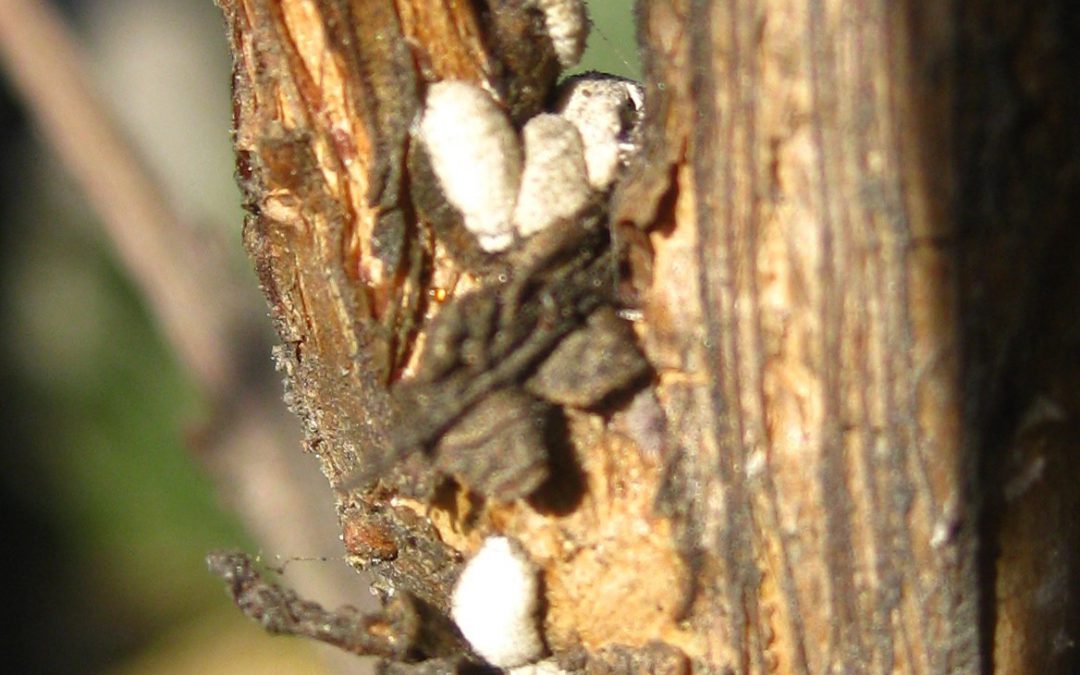
by Mary Salinas | May 6, 2021
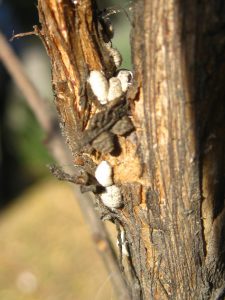
Crapemyrtle bark scale are often found in branch crotches and wounds to the bark. Photo credit: Gary Knox, UF/IFAS.
There is a new pest in the western panhandle of Florida. Crapemyrtle bark scale (CMBS) is a scale that is found on the trunks, branches, and twigs of crapemyrtle. It is the only known scale insect found on the bark of crapemyrtle. There are other scales that occur on the leaves.
When scouting for this pest, look for very small (2 mm or 0.08 inch) white or light gray spots on the bark of crapemyrtle. The adult females do not ever move once they have found a place to feed and reproduce. Under her protective covering, she lays eggs that hatch into ‘crawlers’ that then crawl away to find their own spot to settle down. When squished, they exude a pink goo (the eggs or newly hatched crawlers). Males are winged and travel to find their mates. See this comprehensive information on their interesting biology.
While the scale does not outright kill the trees, it lessens their landscape value and can reduce flowering. And like other scale, CMBS secretes lots of honeydew; black sooty mold then feeds and grows on the honeydew. The black sooty mold does not harm the plants directly, but it is unsightly and can interfere with photosynthesis if present on the leaves.
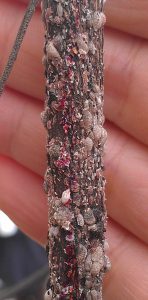
Crapemyrtle bark scale are white to gray and ooze pink when squished. Photo credit: Gary Knox, UF/IFAS. ,
Unfortunately, CMBS has also been found on a very popular native bush, American beautyberry, Callicarpa americana, and it is yet unknown whether CMBS will expand its host range to other plant species in our country. In Asia, this pest has been found on some economically important crops like pomegranate and persimmon.
CMBS is a tough insect to control. And it is best left to the professionals. Dr. Adam Dale, an entomologist at the University of Florida, recommends using pyriproxyfen (in the product Distance) or buprofezin (in the product Talus). These are insect growth regulators that have shown to provide great control of CMBS and other similar scale insects on trees and other woody plants. Although these products are not systemic, they are translaminar, which helps increase their control and reduce any non-target effects on beneficial insects like bees. Two applications 7–14 days apart are suggested. However, these products can only be applied by licensed pest control applicators.
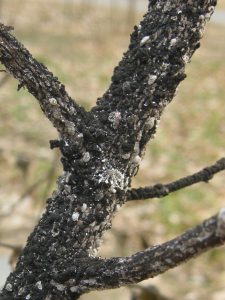
Severe infestation of crapemyrtle bark scale and sooty black mold. Photo credit: Gary Knox, UF/IFAS.
Systemic insecticide drenches are effective but pose a dangerous hazard to bees and other pollinators as the poison also gets into the flower nectar. The product labels prohibit application of these type of products to flowering plants for that very reason.
Routine close inspection of your crapemyrtle trees is critical for CMBS control. Early treatment will help prevent heavy infestations as seen in some of the photographs. When pruning your crapemyrtles, thoroughly clean your tools between plants to prevent any accidental spread.
Prevent this scale from coming into your landscape in the first place. Inspect all new plants you are considering adding to your landscape for any sign of CMBS or other insect or disease presence.
If you have any questions on making the correct identification of CMBS, or any other insect, contact your county extension office.
Lastly, consider reporting the presence of this new scale to enable researchers to track its spread.
For more information:
Stop CMBS Website
UF/IFAS Featured Creatures: crapemyrtle bark scale
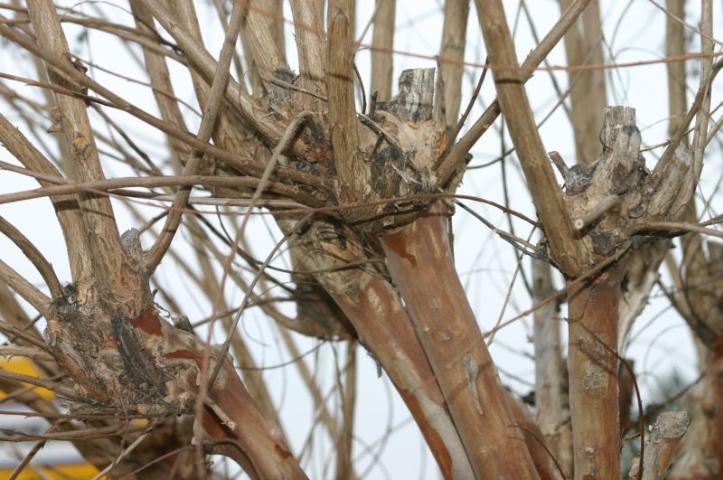
by Sheila Dunning | Feb 5, 2018
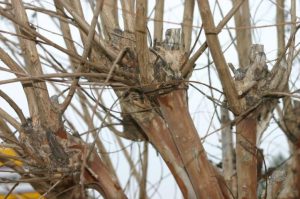 Pruning is one of the most controversial aspects of maintaining crapemyrtle. Traditionally, many crapemyrtles are routinely topped, leaving large branch and stem stubs. This practice has been called “crape murder” because of the potential impacts on the crapemyrtle health and structural integrity. Topping is the drastic removal of large-diameter wood (typically several years old), with the end result of shortening all stems and branches.
Pruning is one of the most controversial aspects of maintaining crapemyrtle. Traditionally, many crapemyrtles are routinely topped, leaving large branch and stem stubs. This practice has been called “crape murder” because of the potential impacts on the crapemyrtle health and structural integrity. Topping is the drastic removal of large-diameter wood (typically several years old), with the end result of shortening all stems and branches.
Hard pruning (topping) stimulates crapemyrtle sprouting from roots, upper stems, or the base of main stems. If basal and root sprouts are not removed, one or more may form woody stems that eventually compete with existing main stems. These additional or competing stems may result in poor form and structure, such as stems that rub against each other.
Topping typically delays flowering up to one month compared to unpruned crapemyrtle. On some cultivars, topping also shorten the season of bloom. Long-stem sprouts emerge just below large-diameter cuts that result from topping. These sprouts usually develop into upright, unbranched stems that eventually flower, often bending under their own weight. Rain or wind storms can cause extreme bending and some will break because they are weakly attached to the main stem.
Topping removes large amounts of starches and other food reserves stored within branches. Topping dramatically reduces the size of the plant canopy, ultimately decreasing the plant’s ability to produce food (starches) through photosynthesis. The large branch stubs caused by topping result in large areas of exposed wood that allow access by insects and wood-rotting organisms, weakening the plant’s structure. Finally, topping results in many dead stubs throughout the tree.
Proper pruning may be needed, just like any other tree. Lower limbs of crapemyrtle are removed to increase clearance for pedestrians or vehicles. Stems are cut to increase branching. Other pruning may be conducted to direct growth away from structures, stimulate flowering, and remove spent flowers, seed capsules, and dead or damaged branches and twigs.
Properly placed, crapemyrtle is a low-maintenance plant needing little or no pruning. Problems with overgrown, misshapen, or misplaced crapemyrtle can be greatly reduced with proper selection of crapemyrtle cultivars, proper plant selection at the nursery, and proper placement in the landscape. For more information on cultivar selection go to: http://edis.ifas.ufl.edu/mg266.
If pruning is necessary, use the following recommendations:
- Pruning for safety may be done anytime. This may involve removing damaged or weak branches or pruning lower limbs for pedestrian and vehicle clearance and visibility.
- Pruning to improve plant structure, redirect growth, or alter plant shape and appearance should occur when plants are leafless and dormant–typically December through February. Although this can be accomplished at any time, without leaves, the branching structure is clearly visible to more easily determine appropriate branches for pruning.
- Prune to remove crossing or rubbing branches.
- Prune dead, damaged, or diseased branches at the branch collar.
- Remove vigorous branches growing toward the center of the canopy.
- Severe pruning should be performed late in the dormant period. Pruning too early might stimulate new growth that could be damaged by low temperatures.
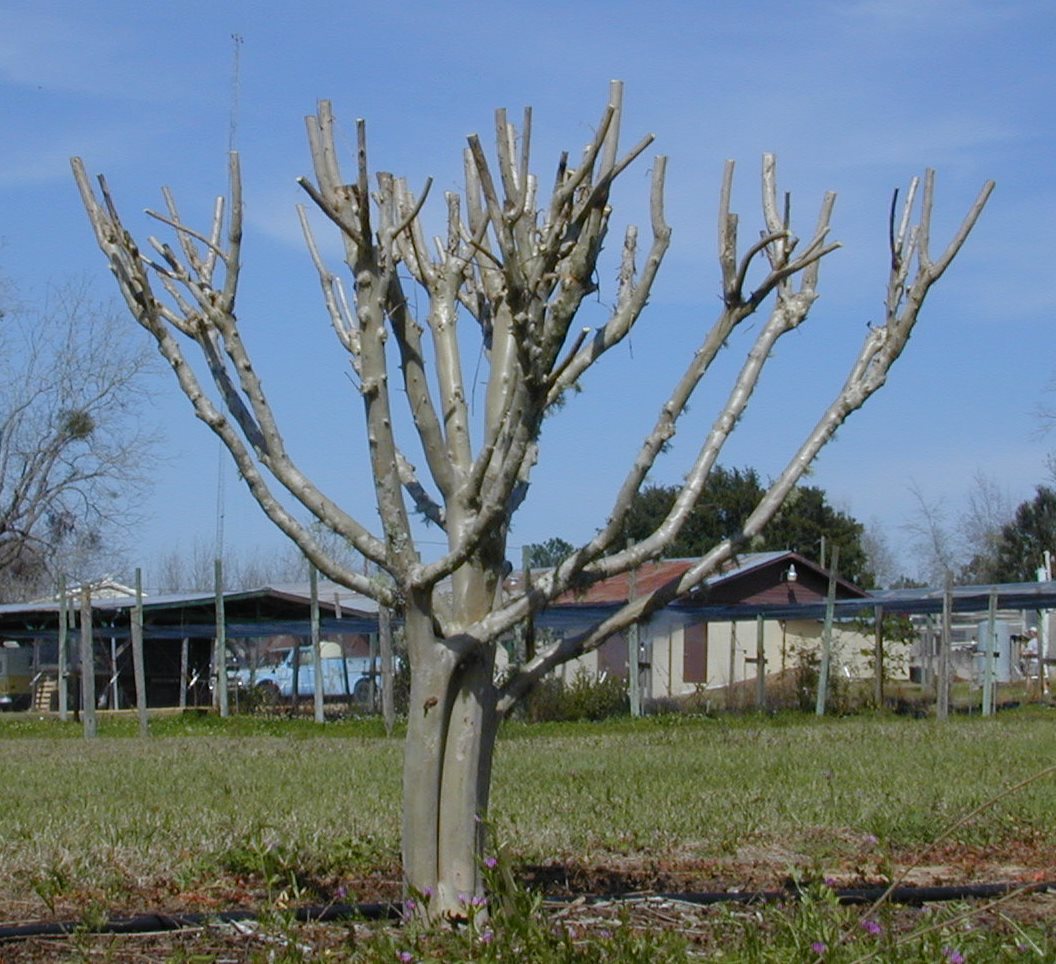
by Gary Knox | Jun 23, 2015
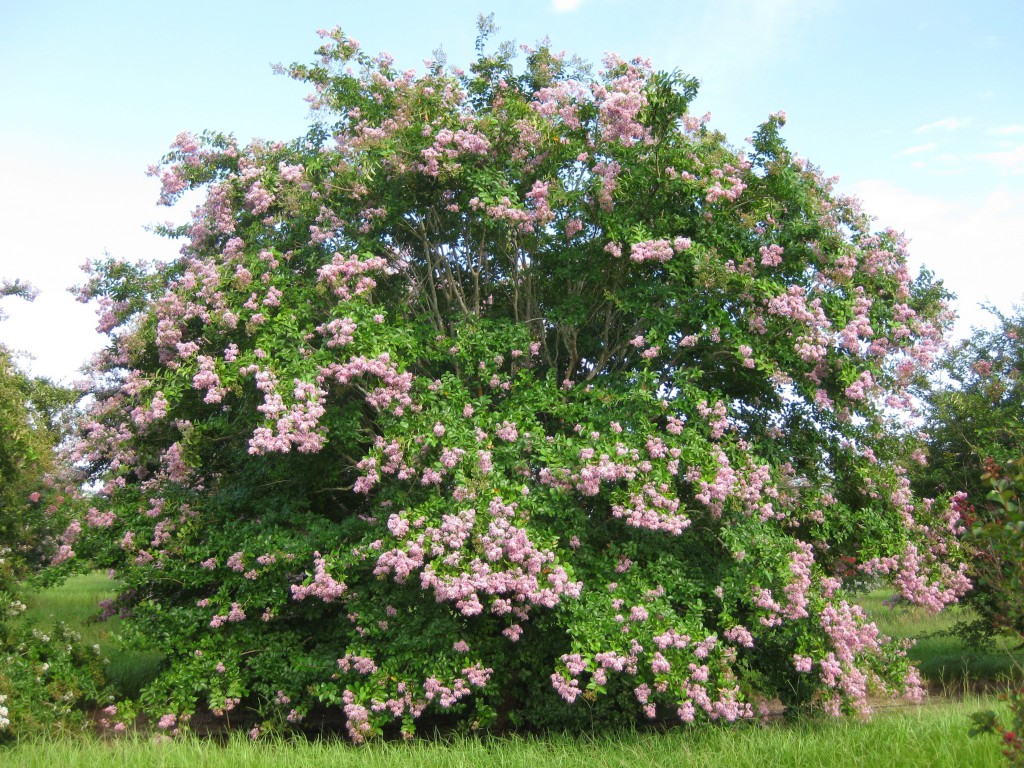
Figure 3. With proper cultivar selection and placement in the landscape, crapemyrtle develops into a beautifully shaped tree that rarely needs pruning. This crapemyrtle is ‘Muskogee’. Image Credit Gary Knox
Crapemyrtle flowering is set to be spectacular this year! While most other garden plants droop from summer’s heat, humidity and heavy rains, crapemyrtle thrives and puts on an outstanding show of flowers all summer and fall. Thanks to modern breeders, we have all sizes of improved hybrid crapemyrtles with flower colors of lavender, purple, white, pink, or red.
Just say “No” to Pruning
Crapemyrtle varieties come in tree-size, patio tree and shrub categories. Tree-size crapemyrtles grow 25 ft. tall and are ideal as flowering trees. Patio tree-form plants (up to 12 ft.) are beautiful as small, flowering specimen plants near patios, walkways, and entrances. Shrub forms (up to 6 ft.) make excellent accents in a shrub border and smaller types are effective as large groundcovers or container plants. Make sure you buy the right size crapemyrtle for your home. Don’t make the mistake of planting a tree-size crapemyrtle in an area too small for its ultimate size, or you’ll find yourself pruning it hard – and often – to keep it from out-growing its place.
Recommended Varieties
Some of the best tree-size (25 ft.) types are Natchez (white), Red Rocket® (red), Sioux (pink) and Apalachee (lavender). Superior patio tree crapemyrtles (12 ft.) are Acoma (white), Cheyenne (true red), Tonto (fuchsia red), Hopi (pink) and Catawba (purple). Smaller shrub (6 ft.) crapemyrtles are hard to find, but Cherry Dazzle® is a nice mounding red and Pixie White and New Orleans (purple) are good selections.
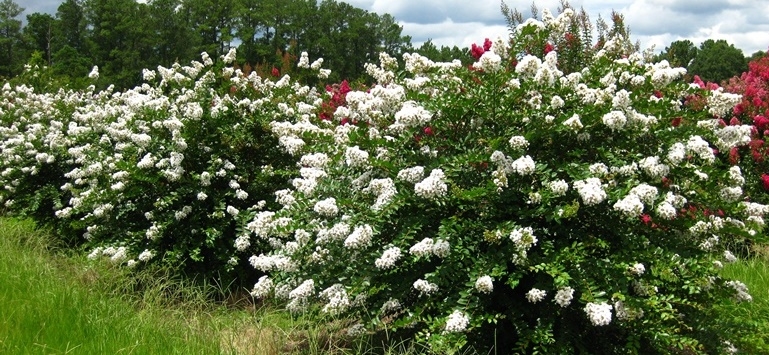
Planting and Garden Care
When it comes to planting, crapemyrtle is very tolerant and forgiving with three exceptions. Firstly, crapemyrtle needs sun to flower freely, so plant it in a site receiving at least six hours of direct sunlight each day. Secondly, crapemyrtle will not grow in wet soils. Finally, never plant crapemyrtle too deep — if you do so, it will punish you by not flowering for years and years. Planting too deep literally smothers the roots, requiring the crapemyrtle to regenerate a new root system in the soil above.
Crapemyrtle is very drought tolerant and almost seems to thrive on neglect. On the other hand, regular watering and fertilizer will help crapemyrtle grow faster and bigger.
More Beauty on the Way!
Breeders are continuing to improve and introduce new crapemyrtles. Many new varieties were released in the last couple years. In particular, watch for new types with purple-burgundy leaf color all summer long! Time will tell which new ones grow best in our area. Stay tuned as the world of crapemyrtle continues to evolve and improve!
*Gary Knox is Professor of Environmental Horticulture with the University of Florida. He is stationed at the North Florida Research and Education Center in Quincy, where he evaluates more than 100 cultivars of crapemyrtle.

by Gary Knox | Feb 3, 2015

Figure 1. Topping is the drastic removal of large-diameter wood (typically several years old) with the end result of shortening all stems and branches. Topping is not recommended for crapemyrtle.
As the holidays fade and the New Year begins, we often see crapemyrtles being “mutilated” from improper pruning: main stems that are several years old are cut back, often leaving branch stubs 2 – 5 inches or more in diameter. This form of crapemyrtle mistreatment goes by various names, including topping, heading, stubbing, rounding, dehorning and (my favorite) “crape murder”.
Whatever you call it, topping a crapemyrtle is almost always unnecessary. Over the years, many people viewed this type of improper pruning and unthinkingly perpetuated the practice in their own yards, not realizing the unfortunate consequences.
Research at the University of Florida found that topping crapemyrtle delays flowering up to one month. For example, unpruned trees may begin flowering in June whereas topped trees begin flowering in July. This research also found topping reduced the number of flowers and shortened the flowering season. Finally, topping stimulated more summer sprouting from roots and stems. Sprouting results in greater maintenance since sprouts are usually removed to maintain an attractive plant appearance.
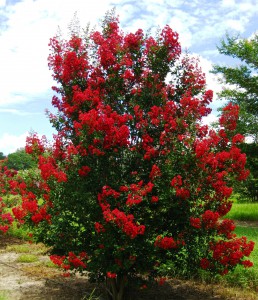
Figure 2. With proper cultivar selection and placement in the landscape, crapemyrtle develops into a beautifully shaped tree that rarely needs pruning. This crapemyrtle is Red Rocket®.
If a crapemyrtle is located where it requires routine pruning to fit into its surroundings (for example, under the eave of a roof), it should be replaced with a smaller growing crapemyrtle. A dwarf crapemyrtle (maturing at a height of 5 feet) would fit this location well. Medium crapemyrtle cultivars (growing up to about 15 feet in height) and tall or tree-size crapemyrtle cultivars (often growing 20 – 30 feet tall in 10 years) are best reserved for open areas.
Crapemyrtle thrives under full sun conditions in areas with ample room for the cultivar size and away from walkways and roads. Proper selection of crapemyrtle cultivar and proper placement in the landscape can result in a low maintenance crapemyrtle without the need for significant pruning.
For more information, please see Crapemyrtle Pruning.
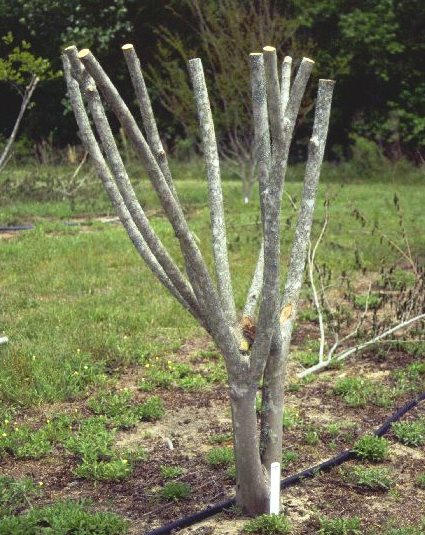
by Gary Knox | Feb 11, 2014
This is the time of year when we often see crapemyrtles unnecessarily topped: main stems that are several years old are cut back, often leaving branch stubs 2 – 5 inches or more in diameter. Topping is sometimes called heading, stubbing, rounding and dehorning.

Figure 1. Topping is the drastic removal of large-diameter wood (typically several years old) with the end result of shortening all stems and branches. Topping crapemyrtle is often referred to as “crape murder” because topping usually is not recommended for crapemyrtle. Image Credit Dr. Gary Knox
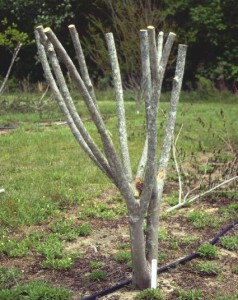
Figure 2. Topping is the drastic removal of large-diameter wood (typically several years old) with the end result of shortening all stems and branches. Topping crapemyrtle is often referred to as “crape murder” because topping usually is not recommended for crapemyrtle. Image Credit Dr. Gary Knox
In the case of crapemyrtles, another name for this practice is “crape murder”. Topping a crapemyrtle is almost always unnecessary. Because people have seen this done in previous years, home owners often mimic this practice in their own yards, not realizing the unfortunate consequences.
Research at the University of Florida, detailed in this linked publication, found that topping crapemyrtle (“crape murder”) delays flowering up to one month. In other words, unpruned trees may begin flowering in June whereas topped trees don’t flower until July. This research also found topping reduced the number of flowers and shortened the flowering season. Finally, topping stimulated more summer sprouting from roots and stems. Sprouting results in greater maintenance since sprouts are usually removed to maintain an attractive plant appearance.
Unfortunately, landscape professionals and home owners often must maintain crapemyrtles that others planted, and so must deal with the consequences of poor cultivar selection and/or placement. If a crapemyrtle requires routine pruning to fit into its surroundings, it should be replaced with a smaller maturing cultivar. Dwarf crapemyrtles mature at a height of 5 feet; medium crapemyrtle cultivars grow up to about 15 feet in height, and tall or tree-size crapemyrtle cultivars exceed 15 feet and often grow to 20 – 30 feet tall in 10 years.
Best locations for crapemyrtle are areas in full sun with plenty of room for the cultivar size and away from walkways and roads. Proper selection of crapemyrtle cultivar and proper placement in the landscape can result in a low maintenance crapemyrtle without the need for significant pruning.

Figure 3. With proper cultivar selection and placement in the landscape, crapemyrtle develops into a beautifully shaped tree that rarely needs pruning. This crapemyrtle is ‘Muskogee’. Image Credit Gary Knox
For more information, see ENH1138, Crapemyrtle Pruning.














